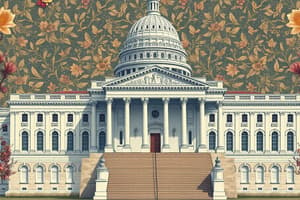Podcast
Questions and Answers
What is the ______ of the government?
What is the ______ of the government?
purpose
How does the _____ branch create laws?
How does the _____ branch create laws?
Legislative
How does the _____ branch execute laws?
How does the _____ branch execute laws?
Executive
How does the _____ branch interpret the laws?
How does the _____ branch interpret the laws?
How should the _____ get along with each other?
How should the _____ get along with each other?
How can the constitution be _____ or changed?
How can the constitution be _____ or changed?
How does _____ work?
How does _____ work?
What _____ have to be taken to make the constitution the law of the land?
What _____ have to be taken to make the constitution the law of the land?
What changes have been made to the _____?
What changes have been made to the _____?
What is the legislative branch responsible for?
What is the legislative branch responsible for?
What does it mean to ratify?
What does it mean to ratify?
What does it mean to execute a law?
What does it mean to execute a law?
What is the term for the system where the national government shares power with state governments?
What is the term for the system where the national government shares power with state governments?
What is a Republican form of government?
What is a Republican form of government?
How many senators are in the US Senate?
How many senators are in the US Senate?
What was added to the Constitution that listed rights not already in the Constitution?
What was added to the Constitution that listed rights not already in the Constitution?
What does the Constitution say is the supreme law of the land?
What does the Constitution say is the supreme law of the land?
What is the term for members of the House of Representatives?
What is the term for members of the House of Representatives?
What does the executive branch ensure?
What does the executive branch ensure?
What does the judicial branch do?
What does the judicial branch do?
What article discusses how states should interact with each other?
What article discusses how states should interact with each other?
What article became known as the Supreme Law of the Land?
What article became known as the Supreme Law of the Land?
What articles create the three branches of the U.S. government?
What articles create the three branches of the U.S. government?
What term refers to additions to the Constitution?
What term refers to additions to the Constitution?
What article details how to amend the Constitution?
What article details how to amend the Constitution?
What article outlines how to ratify the Constitution?
What article outlines how to ratify the Constitution?
Flashcards are hidden until you start studying
Study Notes
Preamble
- Establishes the purpose of the Constitution.
- Defines the role and function of the government.
Article 1: Legislative Branch
- Responsible for creating laws.
- Discusses the powers and responsibilities of state governments.
Article 2: Executive Branch
- Outlines the execution and enforcement of laws.
Article 3: Judicial Branch
- Defines the interpretation and application of laws.
Article 4: Relations Among States
- Addresses how states should interact with and respect each other.
Article 5: Amendments
- Describes the process for amending or changing the Constitution.
Article 6: Federalism
- Details the workings of federalism.
- Establishes the supremacy of federal law over state law.
Article 7: Ratification
- Lists the steps required to ratify the Constitution.
Amendments
- Refers to changes made to the Constitution over time.
Legislative Branch Functions
- Involved in writing bills and creating laws.
- Engages in floor debates during the legislative process.
Executive Branch Functions
- Responsible for enforcing laws and managing government operations.
Judicial Branch Functions
- Interprets laws through court cases and rulings.
Federalism
- A system where power is shared between national and state governments.
Republican Government
- Represents a form of government where officials are elected to represent the people's interests.
Proposed Amendments
- Refers to introducing new amendments for consideration.
Number of Senators
- There are 100 senators in the U.S. Senate.
Necessary and Proper Clause
- Added to the Constitution to address rights not explicitly mentioned.
Supreme Law of the Land
- U.S. laws and federal laws take precedence over state laws.
Term Length for House of Representatives
- Members serve a term of 2 years.
Judicial Decision-Making
- Courts determine the meaning of laws based on facts, not feelings.
Article 4: State Interactions
- Discusses the relationships and obligations between states.
Article 6: Supremacy Clause
- States that the Constitution and federal laws are the highest laws.
Creation of Branches
- Articles 1-3 establish the three branches of government: legislative, executive, and judicial.
Amendments as Additions
- Amendments function as additions to the Constitution, extending its provisions.
Article 5: Amendment Process
- Outlines the specific steps to amend the Constitution.
Article 7: Ratification Process
- Describes how the Constitution is ratified by states.
Studying That Suits You
Use AI to generate personalized quizzes and flashcards to suit your learning preferences.




